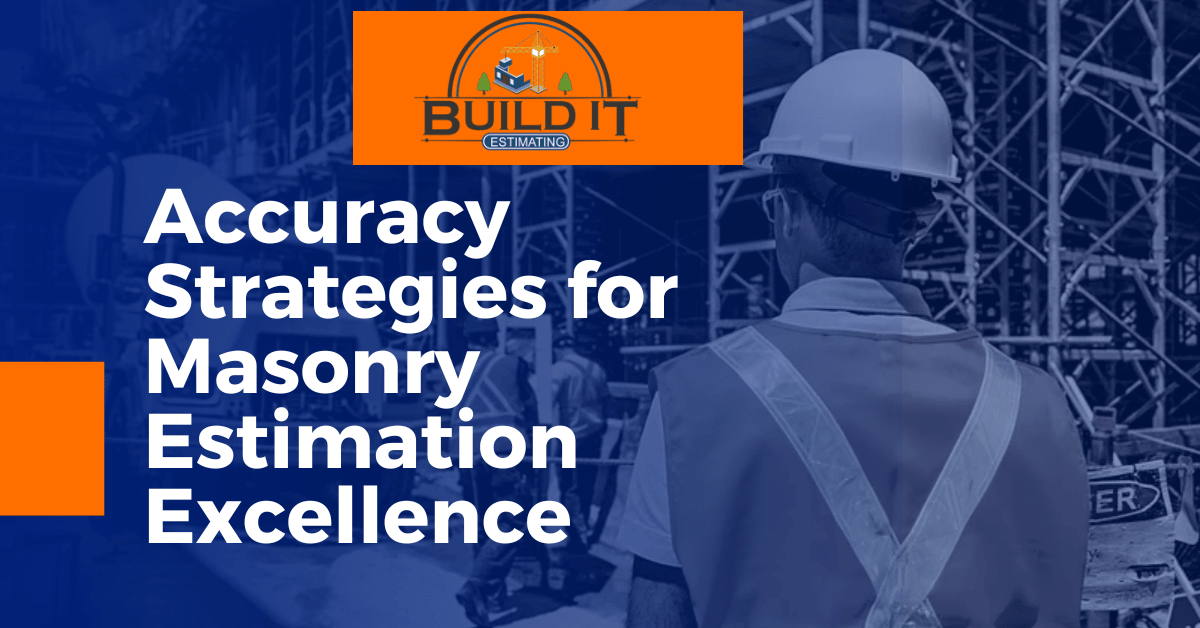Accurate masonry estimation is a cornerstone of successful construction projects. Masonry work, which includes tasks such as bricklaying, blockwork, and stone masonry, requires precise cost assessments to ensure project viability and profitability. Inaccurate estimates can lead to significant financial losses, project delays, and compromised quality. Therefore, implementing effective accuracy strategies in masonry estimation is essential for achieving excellence in the construction industry.
Understanding Masonry Estimation
Masonry estimation involves calculating the total cost of masonry work, including materials, labor, equipment, and overhead. It requires a deep understanding of the project scope, the types of materials used, the labor force needed, and the tools and equipment required. Challenges in masonry estimation often include variability in material costs, labor productivity rates, and site-specific conditions. Best practices in masonry estimation focus on thorough preparation, detailed documentation, and continuous learning.
Preliminary Steps for Masonry Estimation
Before delving into detailed calculations, certain preliminary steps are essential:
Reviewing Plans: Thoroughly examine architectural drawings and specifications to understand the scope of the masonry work.
Site Visits: Conduct site visits to assess local conditions, identify potential challenges, and gather essential data.
Understanding Project Scope: Clearly define the project scope, including the types of masonry work required, the materials to be used, and any special requirements.
Detailed Quantity Take-off for Masonry Projects
The quantity take-off process is critical for accurate masonry estimation. This involves measuring and listing all the materials required for the project. Advanced tools and techniques, such as digital takeoff software, can significantly enhance accuracy and efficiency. The following steps are involved in a detailed quantity take-off:
Measuring Areas: Measure the total area of walls, partitions, and other masonry elements.
Calculating Material Quantities: Calculate the quantities of bricks, blocks, stones, mortar, and other materials needed.
Accounting for Waste: Include a waste factor to account for material loss during construction.
Material Cost Estimation for Masonry
Material costs constitute a significant portion of the overall masonry estimate. Key considerations include:
Types of Materials: Identify the types of materials required, such as bricks, blocks, stones, and mortar.
Sourcing: Research and select reliable suppliers to ensure material quality and availability.
Pricing Trends: Monitor market trends to anticipate price fluctuations and secure the best prices.
Labor Cost Estimation in Masonry
Accurate labor cost estimation is crucial for ensuring that the project stays within budget. Factors to consider include:
Labor Requirements: Determine the number of masons and laborers needed based on the project’s scope and complexity.
Skill Levels: Account for different skill levels, from apprentices to master masons, and their corresponding wage rates.
Productivity Rates: Estimate productivity rates based on historical data and industry standards to calculate the total labor hours required.
Equipment and Tool Cost Estimation
The cost of equipment and tools must be factored into the masonry estimate. Considerations include:
Types of Equipment: Identify the necessary equipment, such as scaffolding, mixers, and power tools.
Rental vs. Purchase: Decide whether to rent or purchase equipment based on project duration and cost-effectiveness.
Maintenance Costs: Include maintenance costs for equipment to ensure continuous operation and avoid delays.
Subcontractor Cost Estimation in Masonry
Many masonry projects require specialized subcontractors for specific tasks. Estimating these costs involves:
Selection Criteria: Select subcontractors based on experience, reputation, and cost.
Cost Factors: Consider factors such as scope of work, labor rates, and material costs when negotiating contracts.
Managing Subcontractors: Implement effective management practices to ensure that subcontractors meet deadlines and quality standards.
Overhead and Profit Margins in Masonry Estimates
Calculating overhead and profit margins is essential for creating a realistic and viable masonry estimate. Key considerations include:
Overhead Costs: Include indirect expenses such as administrative salaries, office supplies, utilities, and insurance.
Profit Margins: Determine profit margins that ensure a fair return on investment while remaining competitive.
Using Technology for Masonry Estimation Accuracy
Modern technology has revolutionized masonry estimation, offering tools and software that enhance accuracy and efficiency. Key benefits include:
Software Tools: Utilize digital takeoff and estimating software to automate calculations and reduce errors.
Benefits of Technology: Leverage technology for real-time collaboration, data sharing, and project management.
Common Challenges in Masonry Estimation
Despite advances in technology, masonry estimation remains challenging. Common challenges include:
Accuracy: Ensuring that all costs are accurately estimated.
Data Management: Handling vast amounts of information and ensuring that all data is up-to-date and relevant.
Cost Fluctuations: Dealing with changes in material and labor costs.
Best Practices for Accurate Masonry Estimation
To achieve accurate masonry estimates, it is essential to follow best practices:
Thorough Documentation: Maintain detailed records of all assumptions, calculations, and decisions made during the estimation process.
Updated Pricing: Regularly update cost data based on current market conditions.
Regular Reviews: Conduct regular reviews of estimates with project stakeholders to address any discrepancies.
The Impact of Accurate Masonry Estimates on Project Success
Accurate masonry estimates are crucial for the success of construction projects. They provide a realistic budget, enabling effective cost control and ensuring that the project remains financially viable. Accurate estimates also play a key role in risk management, identifying potential issues early and allowing for proactive mitigation strategies. Confidence in the project’s financial stability enhances stakeholder confidence, making it easier to secure funding and support.
Legal and Regulatory Considerations in Masonry Estimation
Compliance with legal and regulatory requirements is paramount in masonry estimation. Considerations include:
Local Regulations: Ensure that the estimate accounts for all necessary permits, licenses, and inspections required by local authorities.
Insurance: Include the cost of insurance coverage to protect against potential risks and liabilities.
Safety Standards: Adhere to safety standards and regulations to ensure the well-being of workers and the integrity of the project.
Case Studies of Successful Masonry Estimation
Examining case studies of successful masonry estimation can provide valuable insights and lessons learned. These real-world examples illustrate the importance of accuracy, thorough documentation, and effective communication. They also highlight common pitfalls and strategies for overcoming challenges.
Future Trends in Masonry Estimation
The future of masonry estimation is shaped by emerging trends and technologies. Artificial intelligence (AI) and machine learning are poised to revolutionize the estimating process, offering predictive analytics and data-driven insights. These technologies can enhance accuracy by identifying patterns and trends that might be overlooked by human estimators. Sustainability considerations are also becoming increasingly important, with estimators needing to account for eco-friendly materials and practices.
Role of the Estimator in Masonry Projects
Estimators play a critical role in the construction industry, responsible for preparing accurate and reliable masonry estimates. They must possess a deep understanding of construction processes, materials, and market conditions. Strong analytical and mathematical skills are essential, as is attention to detail. The role of the estimator is dynamic and challenging, requiring continuous learning and adaptation to new technologies and industry trends.
Training and Certification for Masonry Estimators
Professional development is key to success in the field of masonry estimation. Various training and certification programs are available to help estimators build their skills and advance their careers. Organizations such as the American Society of Professional Estimators (ASPE) and the Mason Contractors Association of America (MCAA) offer certification programs that validate an estimator’s expertise and knowledge. Continuing education is also important, as it ensures that estimators stay current with industry developments and best practices.
ACCURACY STRATEGIES FOR MASONRY ESTIMATION EXCELLENCE
Accurate masonry estimation is essential for the success of construction projects. By understanding the key components, following best practices, and leveraging modern technology, estimators can provide reliable estimates that ensure projects are completed on time and within budget. The continued evolution of estimating techniques and technologies promises to further enhance the accuracy, efficiency, and sustainability of masonry estimation in the future.
Conclusion
Achieving excellence in masonry estimation requires a combination of thorough preparation, detailed documentation, and continuous learning. By implementing effective accuracy strategies and leveraging modern technology, estimators can provide reliable estimates that ensure the success of construction projects. As the construction industry evolves, the role of the estimator will continue to be crucial in navigating new challenges and opportunities, driving greater accuracy, efficiency, and sustainability in masonry estimation.

